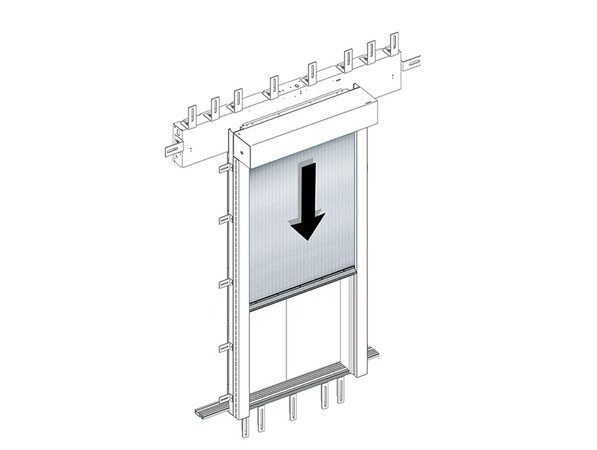Spread of smoke in buildings
Fire catastrophes repeatedly make clear just how necessary it is not just to prevent the spread of fire, but also of smoke in buildings. Lift doors according to EN 81-58 reliably prevent fire spreading.
But the lift shaft runs through the centre of the building, crossing several fire compartments. Smoke continues to get into the lift shaft through the chimney effect and can spread through different fire compartments.
By Jürgen Kral
The demands on the performance of lift doors rise with the size of a building in the same proportion as the requirements for fire protection. The bigger the building, the greater the requirements on the lift doors in terms of performance, speed, noise and energy. As a result, the moveable components of a door must work as far as possible without contact with each other. The fire resistance class is defined in EN 81-58 or ISO 3008.
Due to the gap required for operation, there is a great deal of permeability. The familiar solutions here are for example a "door in front of a door" to distribute fire protection and smoke protection across two components. Thus, combining both properties in one product would be a lasting enhancement of safety in buildings.
Smoke extraction in the shaft would be considerably improved and fire protection planners would have more planning freedom. Furthermore, such a product would simplify the effort for maintenance and care, since both properties would be maintained by a single maintenance company.
Performance or smoke protection?
Theoretically, sealing fire-tested doors with corresponding materials retrospectively would be possible. However, this would involve introducing an additional fire load into the door, which would impair the fire approval according to EN 81-58. Furthermore, sealing the gap would reduce the performance of the door.
 Two-leaf, centrally opening landing sliding door in SmokeGuard design. Photo: © Meiller Aufzugtüren
Two-leaf, centrally opening landing sliding door in SmokeGuard design. Photo: © Meiller AufzugtürenThis point of departure makes it clear that performance and smoke protection have to be handled separately. Since performance is important for the use of the lift and a smoke seal only required in the event of fire, there is no reason to maintain both properties permanently. This opens up the possibility of situational treatment of both scenarios.
The products of component manufacturer Meiller Aufzugtüren GmbH from Munich offer solutions for fire protection doors according to EN 81-58. To achieve smoke protection properties, these were combined with a well-known manufacturer’s fire apron, which does not affect the fire approval criteria of the doors.
Protecting the lift shaft against smoke
Meiller SmokeGuard combines a smoke seal with a performance-oriented landing door. Consequently, depending on the situation, the floors can be provided with a seal with very low leakage rates. This favours smoke extraction in the lift shaft, offers fire protection planners more liberties and simplifies maintenance and care of the entire system.
The modular management of SmokeGuard permits communication with the fire alarm control centre and lift controller. As a result, the individual fire aprons can be opened or closed, depending on the situation. The planning here is provided from one source by the lift builder.
Tested and confirmed
An accredited fire institute has tested and confirmed this combination. The attachment of a fire apron to the fire-tested landing door does not impair the fire resistance class of the door in any way.
The combination of the fire-tested Meiller landing doors with a smoke apron is the first lift landing door solution with integrated smoke seal on the market. To prevent smoke spreading from one floor via the lift shaft to other floors in the event of fire, the smoke apron closes in front of the landing door in order to shield the shaft from the floor.
Consequently, a seal is present for lifts according to floors and the smoke extraction in the building can be channelled in a targeted manner. Triggering of the smoke apron is integrated by the use of a universal controller in all conceivable scenarios (static or dynamic fire management, fire alarm control centre, etc.).
The author is product manager at Meiller Aufzugtüren.
More information: meiller-aufzugtueren.de


























Write a comment